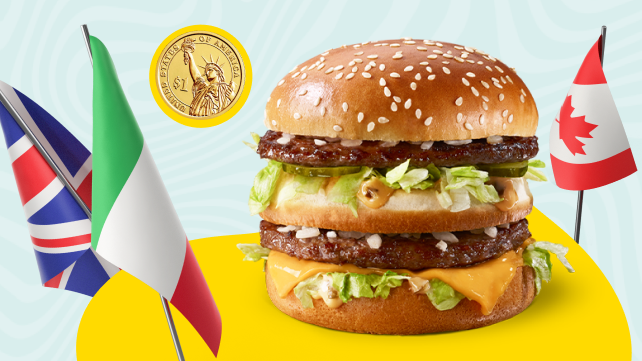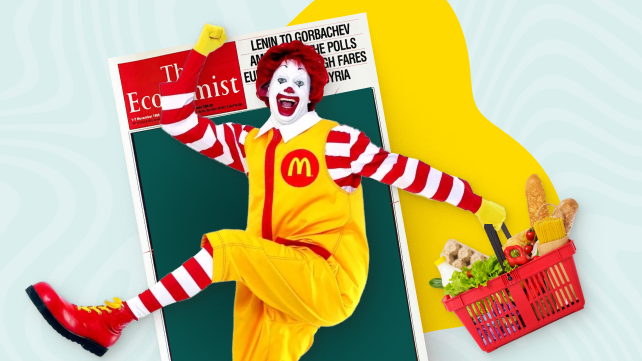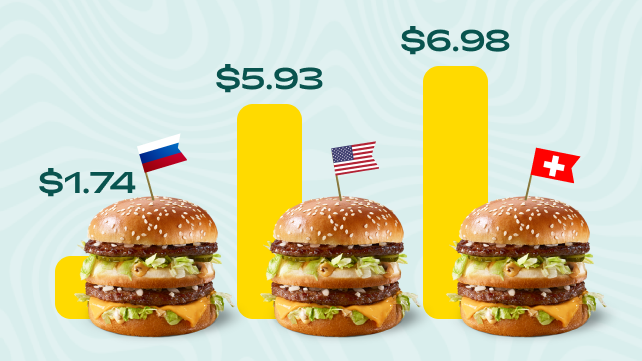What is the Big Mac Index?

Even with all the junk food controversy, Big Mac is known and loved by many all around the globe. But did you know that Big Mac is also an economic indicator?
Read this article to learn about the Big Mac Index, what it means, how it was created, and how you can use it in trading.
Two all-beef patties
Wherever you live – Tokyo, Moscow, Colombo, or Oslo – you can go outside, head to the nearest McDonald’s, and have two all-beef patties, lettuce, cheese, pickles, and onions, all covered with a special sauce and sandwiched between two buns. You can have yourself a Big Mac – roughly 500 calories of joy. Or not, depending on your eating habits.
While, from country to country, Big Macs differ slightly in looks, sizes, and calories, still, the basic formula for the world’s most famous hamburger stays the same.
Big Mac’s ingredients include some of the most common food products available in most countries. Something that regular customers buy daily in local grocery stores: onions, meat, lettuce, cheese, pickles, etc. So you might call it a ready-to-go basket of goods. That’s why in the mid-’80s, The Economist chose this burger’s pricing as a simple tool for currencies analysis.
Introducing the Big Mac Index

The Big Mac Index was invented in 1986 by The Economist, one of the most influential magazines on international business, politics, technology, and culture.
With a history of over 170 years, The Economist is rightfully regarded as the gold standard for economic news and world affairs reports. The magazine’s staff includes talented and highly-trained journalists.
Throughout its existence, The Economist has introduced several indexes, including the Democracy Index, the Glass Ceiling Index, the Most Dangerous Cities Index, Commodity-Price Index, and the Big Mac Index. Based on the prices of Big Macs in different countries, the Index should give, for the lack of a better term, a more correct currency valuation.
Say, we have two countries, the US and China. We compare Big Mac’s prices in these two countries expressed in local currencies. The difference in prices will give us a Big Mac exchange rate, which often differs from what we get from official sources. And then, we can go on with telling if the currency in question is over or undervalued.
With the dollar-yuan Big Mac exchange rate, we get the rough proportion of 1:4 – $5.93 for the hamburger in the US and ¥24.9 in China. The result gives us an alternative idea of how much the Chinese yuan should cost: ¥4.20 for $1 against the official rate of ¥6.7 for a dollar.
This gastronomic approach is also called Burgernomics. It is based on the PPP theory, which stands for Purchasing Power Parity. The concept offers the idea that exchange rates, in the long run, should move towards equalizing the prices for an identical basket of goods and services in any two countries. In this case, the said basket of goods is a Big Mac.
What does the Big Mac Index show?
While the Big Mac Index can hardly be called a precise tool for indicating a currency value, still, the data can give some unexpected results and ideas to think of.
For instance, according to the Big Mac index, the Russian ruble is the world’s most undervalued currency (-69.9%). As of the latest release, one dollar costs over 70 rubles, while a Big Mac in Russia will cost you only $1.74, the burger’s lowest price in the world! So from the Big Mac Index perspective, one dollar should cost only 23 rubles.

Other undervalued currencies include the Turkish lira, the Lebanese pound, the Malaysian ringgit, the Indonesian rupiah, and the Romanian leu.
Big Mac Index shows that Switzerland’s franc is the world's most overvalued currency. A Big Mac will cost you 6.98 US dollars in Switzerland with the Big Mac Index rate of 1.12 francs per dollar. However, the currency exchange markets show that the USDCHF rate is 0.93. This means that the Swiss currency is overvalued by 20.16%. Again, that is if we choose to simplify the economics, putting all the correlating data and factors aside.
Can we use the Big Mac price comparison for trading?
Despite the funny name, the Big Mac Index or Burganomics is not just a funny way to fiddle with the economy. It has become a global standard over the years. Today, several economic textbooks and a wide variety of academic studies include it as a useful tool for currency comparison.
But is it a good forecasting tool one can use for trading?
One of the reasons a trader may use the Index for market forecasting is to establish a potential road map for where the market may be heading. However, one should consider multiple factors affecting the price of a hamburger. Plus, exchange rates are not always the surest indicator of where the market goes.
Conclusion
It is important to remember that the Big Mac Index doesn’t consider the small, short-term fluctuations of the Forex market. It focuses on the long term instead. However, when paired with other indicators and backed up with a bunch of different market data, the Index might come in handy, adding to your existing trading arsenal.
For example, you can address the Big Mac Index when trading Forex with FBS to see how it will affect your strategy and results.
FAQ
What is the Big Mac Index?
The Big Mac Index is a tool invented by the Economist in 1986 to measure the imbalances in consumer purchasing power between nations. The Index uses the burger as the substitute for the "basket of goods", a traditional economic indicator for differences in consumer pricing.
What does the Big Mac Index compare?
The Big Mac Index compares the price of the famous burger in different countries to give an alternative view of how national currencies are valued. The results often contradict official exchange rates.
How may currencies be overvalued or undervalued?
Currencies get overvalued or undervalued depending on whether there is a need to balance trade. With an undervalued currency, the country’s goods are more affordable in the global market. An overvalued currency will raise import expenses.
Is the Big Mac Index an appropriate test for PPP?
The Big Mac Index is an excellent example of how PPP works. However, one should not view the Index as a universal currency comparison tool.
What Is the Big Mac PPP?
The Big Mac PPP (for Purchasing Power Parity) is an annual report that compares various currencies based on the relative price of a Big Mac across the world.




